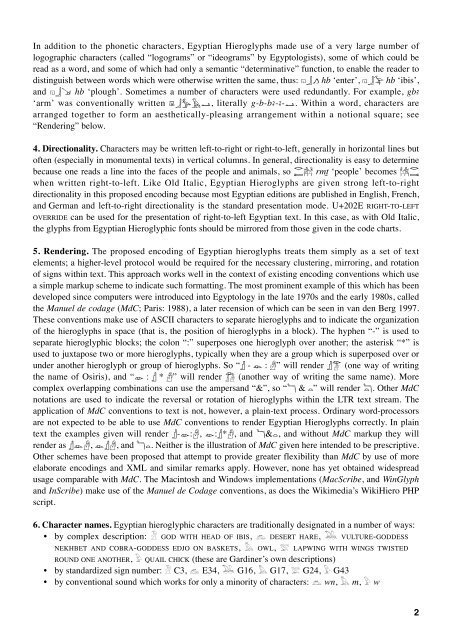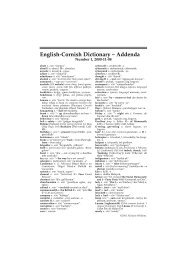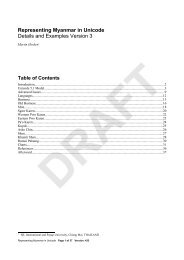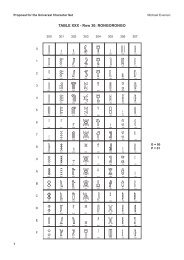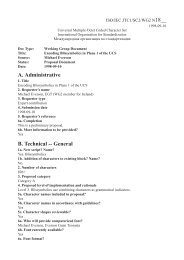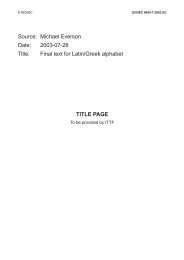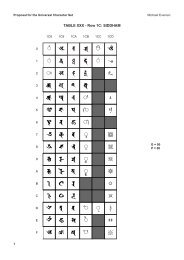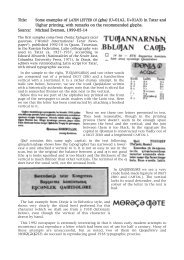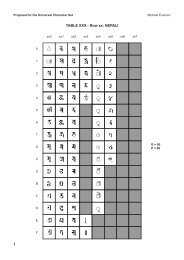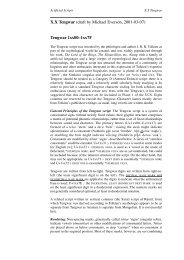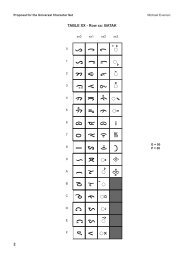ISO/IEC JTC1/SC2/WG2 N3xxx L2/07-xxx - Evertype
ISO/IEC JTC1/SC2/WG2 N3xxx L2/07-xxx - Evertype
ISO/IEC JTC1/SC2/WG2 N3xxx L2/07-xxx - Evertype
You also want an ePaper? Increase the reach of your titles
YUMPU automatically turns print PDFs into web optimized ePapers that Google loves.
In addition to the phonetic characters, Egyptian Hieroglyphs made use of a very large number of<br />
logographic characters (called “logograms” or “ideograms” by Egyptologists), some of which could be<br />
read as a word, and some of which had only a semantic “determinative” function, to enable the reader to<br />
distinguish between words which were otherwise written the same, thus: ∫ªº hb ‘enter’, ∫ªΩ hb ‘ibis’,<br />
and ∫ªæ hb ‘plough’. Sometimes a number of characters were used redundantly. For example, gb¨<br />
‘arm’ was conventionally written ƒ†©•ù, literally g-b-b¨-¨-ù. Within a word, characters are<br />
arranged together to form an aesthetically-pleasing arrangement within a notional square; see<br />
“Rendering” below.<br />
4. Directionality. Characters may be written left-to-right or right-to-left, generally in horizontal lines but<br />
often (especially in monumental texts) in vertical columns. In general, directionality is easy to determine<br />
because one reads a line into the faces of the people and animals, so «» rmt ‘people’ becomes …Œ<br />
¯<br />
when written right-to-left. Like Old Italic, Egyptian Hieroglyphs are given strong left-to-right<br />
directionality in this proposed encoding because most Egyptian editions are published in English, French,<br />
and German and left-to-right directionality is the standard presentation mode. U+202E RIGHT-TO-LEFT<br />
OVERRIDE can be used for the presentation of right-to-left Egyptian text. In this case, as with Old Italic,<br />
the glyphs from Egyptian Hieroglyphic fonts should be mirrored from those given in the code charts.<br />
5. Rendering. The proposed encoding of Egyptian hieroglyphs treats them simply as a set of text<br />
elements; a higher-level protocol would be required for the necessary clustering, mirroring, and rotation<br />
of signs within text. This approach works well in the context of existing encoding conventions which use<br />
a simple markup scheme to indicate such formatting. The most prominent example of this which has been<br />
developed since computers were introduced into Egyptology in the late 1970s and the early 1980s, called<br />
the Manuel de codage (MdC; Paris: 1988), a later recension of which can be seen in van den Berg 1997.<br />
These conventions make use of ASCII characters to separate hieroglyphs and to indicate the organization<br />
of the hieroglyphs in space (that is, the position of hieroglyphs in a block). The hyphen “-” is used to<br />
separate hieroglyphic blocks; the colon “:” superposes one hieroglyph over another; the asterisk “*” is<br />
used to juxtapose two or more hieroglyphs, typically when they are a group which is superposed over or<br />
under another hieroglyph or group of hieroglyphs. So “¬ - √ : ƒ” will render ¬≈ (one way of writing<br />
the name of Osiris), and “√ : ¬ * ƒ” will render ∆ (another way of writing the same name). More<br />
complex overlapping combinations can use the ampersand “&”, so “À & Ô will render Õ. Other MdC<br />
notations are used to indicate the reversal or rotation of hieroglyphs within the LTR text stream. The<br />
application of MdC conventions to text is not, however, a plain-text process. Ordinary word-processors<br />
are not expected to be able to use MdC conventions to render Egyptian Hieroglyphs correctly. In plain<br />
text the examples given will render ¬-√:ƒ, √:¬*ƒ, and À&Ã, and without MdC markup they will<br />
render as ¬√ƒ, √¬ƒ, and ÀÃ. Neither is the illustration of MdC given here intended to be prescriptive.<br />
Other schemes have been proposed that attempt to provide greater flexibility than MdC by use of more<br />
elaborate encodings and XML and similar remarks apply. However, none has yet obtained widespread<br />
usage comparable with MdC. The Macintosh and Windows implementations (MacScribe, and WinGlyph<br />
and InScribe) make use of the Manuel de Codage conventions, as does the Wikimedia’s WikiHiero PHP<br />
script.<br />
6. Character names. Egyptian hieroglyphic characters are traditionally designated in a number of ways:<br />
• by complex description: √ GOD WITH HEAD OF IBIS, µ DESERT HARE, ˚ VULTURE-GODDESS<br />
NEKHBET AND COBRA-GODDESS EDJO ON BASKETS, ¸ OWL, É LAPWING WITH WINGS TWISTED<br />
ROUND ONE ANOTHER, ó QUAIL CHICK (these are Gardiner’s own descriptions)<br />
• by standardized sign number: √ C3, µ E34, ˚ G16, ¸ G17, É G24, ó G43<br />
• by conventional sound which works for only a minority of characters: µ wn, ¸ m, ó w<br />
2


